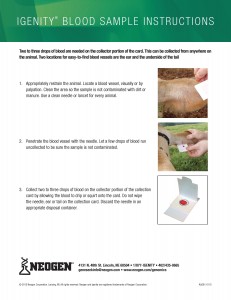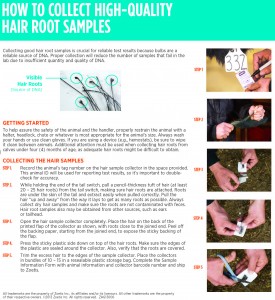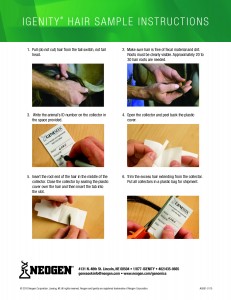How to Collect DNA Samples
Collecting a DNA sample is easy, but collecting a good DNA sample is crucial to receiving prompt and accurate results. As a Beefmaster breeder it is required that DNA samples be collected and processed through Zoetis or Geneseek on all embryo and semen donor dams and sires. The process of collecting quality DNA blood or hair samples is important to understand for all Beefmaster breeders. If a bad DNA sample is provided then the DNA-testing lab cannot efficiently extract the DNA. If you currently, or plan to in the future, collect DNA samples please become familiar with the instructions below. If you are more of a “see-then-do” learner, please view the Hair Sample How to Video or the Blood Sample How to Video.
If you need to order a DNA hair or blood kit, please contact the office at 210-732-3132 or kcrenshaw@beefmasters.org.
How to Collect Blood Samples using Blood Cards
Always wash your hands or use clean gloves. Allow blood samples to dry completely before shipping, but do not dry them in direct sunlight or in a plastic bag. When collecting blood, use a new needle, syringe or pin prick device for each animal. When collecting, packaging and submitting samples for DNA testing, it is critical to eliminate cross-contamination. Rinsing needles is not enough to prevent possible DNA residue. Please follow these simple steps to improve accuracy of test results:
1. Verify the animal’s tattoo and/or tag number and clearly record it on the blood card in the space provided. This ID will be used for reporting results, so it’s important to double-check it for accuracy.
2. Using a new needle or piercing device for each animal, prick a vein in the animal’s ear. As blood forms at the site of the prick, open the blood card and touch it to the drop on the indicated square. Apply only enough blood to the card to fill the two squares outlined, but not so much that the card is soggy and overly saturated. Two or three heavy drops of blood per square is plenty. A syringe may also be used to collect and spot the blood cards.
3. Next, bend the top flap of the card up so that the sample dries while the card is in an open position.
4. Set the blood card aside with the top flap open until dry. Make sure that blood cards do not touch—this is a possible source of DNA cross-contamination. Also, do not dry blood cards in direct sunlight, as UV radiation destroys DNA.
5. Once dry, rubber band closed blood cards together in batches of 10 – 15 and combine several batches together into resealable plastic storage bags.
6. Record the Animal ID along with other animal information on the Zoetis Sample Information Form or the Geneseek DNA Submission Form, such that each sample can be correctly matched with each animal. Barcodes are assigned to the samples upon arrival in the lab.
7. Send DNA sample to Beefmaster Breeders United, 6800 Park Ten Blvd., Suite 290 West, San Antonio, TX 78213
How to Collect High-Quality Hair Root Samples
Collecting good hair root samples is crucial for reliable test results because bulbs are a reliable source of DNA. Proper collection will reduce the number of samples that fail in the lab due to insufficient quantity and quality of DNA.
Getting Started
To help assure the safety of the animal and the handler, properly restrain the animal with a halter, headlock, chute or whatever is most appropriate for the animal’s size. Always wash your hands or use clean gloves. If you are using a device (e.g., hemostats), be sure to wipe it clean between animals. Additional attention must be used when collecting hair roots from calves under four (4) months of age, as adequate hair roots might be difficult to obtain.
Collecting The Hair Samples
Step 1. Record the animal’s tag number on the hair sample collector in the space provided. This animal ID will be used for reporting test results, so it’s important to doublecheck for accuracy.
Step 2. While holding the end of the tail switch, pull a pencil-thickness tuft of hair (at least 20 – 25 hair roots) from the tail switch, making sure hair roots are attached. Roots are under the skin of the tail and extract easily when pulled correctly. Pull the hair “up and away†from the way it lays to get as many roots as possible. Always collect dry hair samples and make sure the roots are not contaminated with feces. Hair root samples also may be obtained from other sources, such as ears or tailhead.
Step 3. Open the hair sample collector completely. Place the hair on the back of the printed flap of the collector as shown, with roots close to the joined end. Peel off the backing paper, starting from the joined end, to expose the sticky backing of the flap.
Step 4. Press the sticky plastic side down on top of the hair roots. Make sure the edges of the plastic are sealed around the collector. Also, verify that the roots are covered.
Step 5. Trim the excess hair to the edges of the sample collector. Place the collectors in bundles of 10 – 15 in a resealable plastic storage bag.
Step 6. Record the Animal ID along with other animal information on the Zoetis Sample Information Form or the Geneseek DNA Submission Form, such that each sample can be correctly matched with each animal. Barcodes are assigned to the samples upon arrival in the lab.
Step 7. Send DNA sample to Beefmaster Breeders United, 6800 Park Ten Blvd., Suite 290 West, San Antonio, TX 78213












